Science Olympiad Stars/Clusters – Flashcards
Unlock all answers in this set
Unlock answersquestion
Altair

answer
Altair (Alpha Aquilae, Alpha Aql, α Aquilae, α Aql, Atair) is the brightest star in the constellation Aquila and the twelfth brightest star in the night sky. It is currently in the G-cloud.
question
Arcturus
answer
Arcturus of the constellation Boötes is the brightest star in the northern celestial hemisphere. It is the fourth brightest star in the night sky.
question
Sirius
answer
Sirius is the brightest star system in the earth's night sky.
question
Procyon
answer
Procyon is the brightest star in the constellation Canis Minor. To the naked eye, it appears to be a single star, the eighth brightest in the night sky. It is actually a binary star system, consisting of a white main-sequence star of spectral type F5 IV-V, named Procyon A, and a faint white dwarf companion of spectral type DQZ, named Procyon B. The reason for its brightness is not its intrinsic luminosity but its relative closeness to the Sun.
question
Deneb
answer
Deneb is the brightest star in the constellation Cygnus and one of the vertices of the Summer Triangle. It is the 19th brightest star in the night sky. A blue-white supergiant, Deneb is also one of the most luminous nearby stars. However, its exact distance (and hence luminosity) has been difficult to calculate, so it is anywhere between 54,000 and 196,000 times as luminous as the sun.
question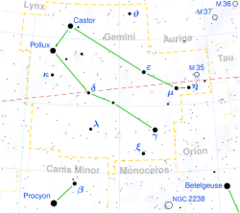
Castor

answer
Castor is the second brightest star in the constellation Gemini and one of the brightest stars in the night sky.
question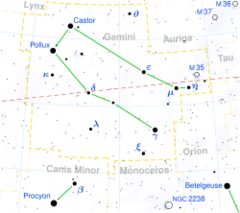
Pollux

answer
Pollux is a star in the northern constellation of Gemini, the Twins. It is an evolved giant star with an orange hue.
question
Regulus
answer
Regulus is the brightest star in the constellation Leo and one of the brightest stars in the night sky, lying approximately 79 light years from Earth. Regulus is a multiple star system composed of four stars that are organized into two pairs.
question
Vega
answer
Vega is the brightest star in the constellation Lyra, the fifth brightest star in the night sky and the second brightest star in the northern celestial hemisphere, after Arcturus. It is a relatively close star at only 25 light-years from Earth, and, together with Arcturus and Sirius, one of the most luminous stars in the Sun's neighborhood.
question
Betelgeuse
answer
Betelgeuse, also known by its Bayer designation Alpha Orionis (shortened to α Orionis or α Ori), is the ninth-brightest star in the night sky and second-brightest in the constellation of Orion. It is distinctly reddish.
question
Rigel
answer
Rigel, also known by its Bayer designation Beta Orionis (β Ori, β Orionis), is the brightest star in the constellation Orion and the seventh brightest star in the night sky.
question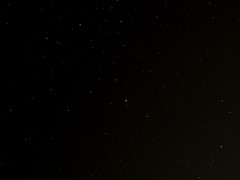
Antares

answer
Antares, also known by its Bayer designation Alpha Scorpii (abbreviated to α Scorpii or α Sco), is the seventeenth brightest star in the nighttime sky[a] and the brightest star in the constellation Scorpius, and is often referred to as "the heart of the scorpion".
question
Aldebaran
answer
Aldebaran is an orange giant star located about 65 light years away in the zodiac constellation of Taurus. With an average apparent magnitude of 0.87 it is the brightest star in the constellation and is one of the brightest stars in the nighttime sky.
question
Pleiades (7 Sisters)
answer
In astronomy, the Pleiades, or Seven Sisters, is an open star cluster containing middle-aged hot B-type stars located in the constellation of Taurus. It is among the nearest star clusters to Earth and is the cluster most obvious to the naked eye in the night sky.
question
Hyades
answer
The Hyades, also known as Melotte 25 or Collinder 50, is the nearest open cluster to the Solar System and one of the best-studied of all star clusters. The Hipparcos satellite, the Hubble Space Telescope, and infrared color-magnitude diagram fitting have been used to establish a distance of ~153 ly (47 pc) to the cluster center.
question
Merak
answer
Beta Ursae Majoris is a star in the northern circumpolar constellation of Ursa Major. It has the traditional name Merak.
question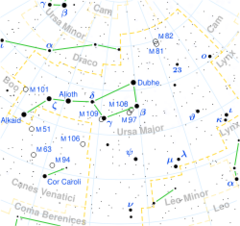
Dubhe

answer
Alpha Ursae Majoris (Alpha UMa, α Ursae Majoris, α UMa) is the second-brightest star in the constellation of Ursa Major (despite its Bayer designation of "alpha"). It has the traditional name Dubhe, and a rarer name Ak.
question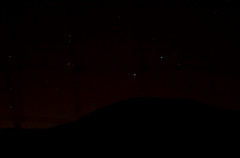
Polaris

answer
Polaris (α UMi, α Ursae Minoris, Alpha Ursae Minoris, commonly North Star, Northern Star or Pole Star, also Lodestar, sometimes Guiding Star) is the brightest star in the constellation, Ursa Minor, and the 45th brightest star in the night sky. It is very close to the north celestial pole, making it the current northern pole star.
question
Spica
answer
Spica is the brightest star in the constellation Virgo, and the 15th brightest star in the night sky. It is a blue giant and a variable star of the Beta Cephei type, 250 light years from Earth.



